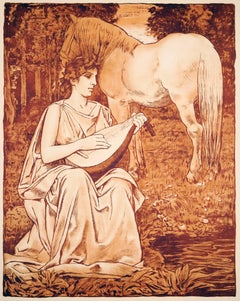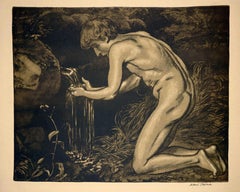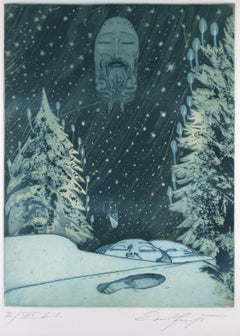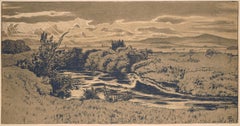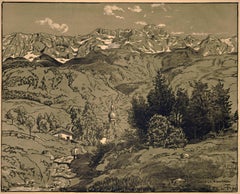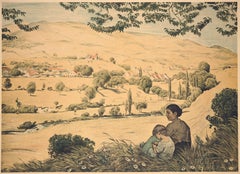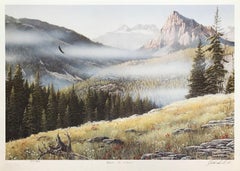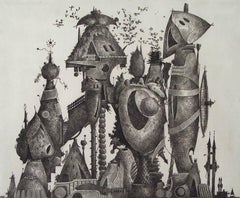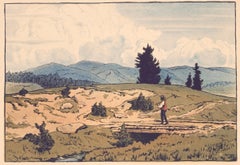Berlin - Landscape Prints
to
5
5
7
1
Overall Width
to
Overall Height
to
2
1
1
1
5
8
1
1
1
3
9
4
5
4
3
3
3
3
2
2
2
1
1
1
1
1
1
1
1
1
1
1
6
6
1
4
11,184
4,720
Item Ships From: Berlin
Muse / - In the realm of the muses -
Located in Berlin, DE
Hans Thoma (1839 Bernau - 1924 Karlsruhe), Muse, 1893. Algraph on strong wove paper, published by Breitkopf und Härtel in Leipzig as ‘Zeitgenössisches Kunstblatt Nr. 174’, 43.5 cm x ...
Category
1890s Realist Berlin - Landscape Prints
Materials
Paper
Boy at the source / - Elixir of Life -
Located in Berlin, DE
Hans Thoma (1839 Bernau - 1924 Karlsruhe), Boy at the source, 1897. Algraph on strong wove paper after a drawing from 1897, published by Breitkopf und Härtel in Leipzig as ‘Zeitgenös...
Category
1890s Realist Berlin - Landscape Prints
Materials
Paper
The Lost Trace / - The Holy Night as a real dream -
By Ernst Fuchs
Located in Berlin, DE
Ernst Fuchs (1930 Vienna - 2015 ibid), The Lost Trace, 1972. Vernis mou and aquatint etching, 46.8 x 36.4 cm (plate), 66 x 50 cm (sheet), 69.5 x 53.5 cm (frame), WVZ Hartmann no. 185...
Category
1970s Surrealist Berlin - Landscape Prints
Materials
Etching
At the pond / - The longing of the landscape -
Located in Berlin, DE
Hans Thoma (1839 Bernau - 1924 Karlsruhe), At the pond, 1897. Algraph on strong wove paper, published by Breitkopf und Härtel in Leipzig as ‘Zeitgenössisches Kunstblatt Nr. 148’, 23....
Category
1890s Realist Berlin - Landscape Prints
Materials
Paper
S. Anton Patenkirchen / - The Home of the Landscape -
Located in Berlin, DE
Hans Thoma (1839 Bernau - 1924 Karlsruhe), S. Anton Patenkirchen, 1895. Algraph on strong wove paper, published by Breitkopf und Härtel in Leipzig as ‘Zeitgenössisches Kunstblatt Nr....
Category
1890s Realist Berlin - Landscape Prints
Materials
Paper
Southern German summer landscape / - The profile of the landscape -
Located in Berlin, DE
Hans Thoma (1839 Bernau - 1924 Karlsruhe), Southern German summer landscape, around 1897. Algraph on strong wove paper, published by Breitkopf und Härtel in Leipzig as ‘Zeitgenössisc...
Category
1890s Realist Berlin - Landscape Prints
Materials
Paper
Dreimaster mit Flagge, 3 und Sonnenuntergang
By Lyonel Feininger
Located in Berlin, DE
One of only several proofs. Signed in pencil lower left 'Lyonel Feininger' and with the artist's work number "1912 b" in pencil, lower center. Prasse records only 4 proof impressions...
Category
1910s Berlin - Landscape Prints
Materials
Woodcut
Evening - The depth of the visible -
Located in Berlin, DE
Max Clarenbach (1880 Neuss - Cologne 1952), Evening. Etching, 18 x 41 cm (platemark), 33.5 x 57 cm (frame), inscribed "Abend" in pencil at lower left, signed and dated "M. Clarenbach. 28.III.[19]09". Framed and mounted under glass.
- Somewhat browned and slightly foxed.
About the artwork
The horizontally elongated etching depicts the panoramic view of a small town as seen from the other side of the river. There are gabled houses on the left and a mighty church spire on the right. The bourgeois houses and the large religious building indicate the urban character. These buildings are rendered in dark tones to emphasise the lighter row of houses in the centre of the picture, closer to the water. The chiaroscuro contrast creates two parallel planes that open up a space for the imagination of what the city could be. The imagination is stimulated by the almost entirely dark, barely recognisable buildings, while the arm of the river leading into the city further stimulates the imagination.
However, as the silhouette of the city as a whole is reflected in the water, the parallel planes are perceived as a band of houses that stretches across the entire horizontality of the etching and seems to continue beyond the borders of the picture. The reflection has almost the same intensity as the houses themselves, so that the band of buildings merges with their reflection to form the dominant formal unit of the picture. Only the parallel horizontal hatching creates the convincing impression of seeing water, demonstrating Max Clarenbach's mastery of the etching needle.
The water is completely motionless, the reflection unclouded by the slightest movement of the waves, creating a symmetry within the formal unity of the cityscape and its reflection that goes beyond the motif of a mere cityscape. A pictorial order is established that integrates everything in the picture and has a metaphysical character as a structure of order that transcends the individual things. This pictorial order is not only relevant in the pictorial world, but the picture itself reveals the order of the reality it depicts. Revealing the metaphysical order of reality in the structures of its visibility is what drives Clarenbach as an artist and motivates him to return to the same circle of motifs.
The symmetry described is at the same time inherent an asymmetry that is a reflection on art: While the real cityscape is cut off at the top of the picture, two chimneys and above all the church tower are not visible, the reflection illustrates reality in its entirety. The reflection occupies a much larger space in the picture than reality itself. Since antiquity, art has been understood primarily as a reflection of reality, but here Clarenbach makes it clear that art is not a mere appearance, which can at best be a reflection of reality, but that art has the potential to reveal reality itself.
The revealed structure of order is by no means purely formalistic; it appears at the same time as the mood of the landscape. The picture is filled with an almost sacred silence. Nothing in the picture evokes a sound, and there is complete stillness. There are no people in Clarenbach's landscape paintings to bring action into the picture. Not even we ourselves are assigned a viewing position in the picture, so that we do not become thematic subjects of action. Clarenbach also refrains from depicting technical achievements. The absence of man and technology creates an atmosphere of timelessness. Even if the specific date proves that Clarenbach is depicting something that happened before his eyes, without the date we would not be able to say which decade, or even which century, we are in. The motionless stillness, then, does not result in time being frozen in the picture, but rather in a timeless eternity that is nevertheless, as the title "Abend" (evening), added by Clarenbach himself, makes clear, a phenomenon of transition. The landscape of the stalls is about to be completely plunged into darkness, the buildings behind it only faintly discernible. The slightly darkened state of the sheet is in keeping with this transitional quality, which also lends the scene a sepia quality that underlines its timelessness. And yet the depiction is tied to a very specific time. Clarenbach dates the picture to the evening of 28 March 1909, which does not refer to the making of the etching, but to the capture of the landscape's essence in the landscape itself.
If the real landscape is thus in a state of transition, and therefore something ephemeral, art reveals its true nature in that reality, subject to the flow of phenomena, is transferred to an eternal moment, subject to a supra-temporal structure of order - revealed by art. Despite this supratemporality, the picture also shows the harbingers of night as the coming darkening of the world, which gives the picture a deeply melancholy quality, enhanced by the browning of the leaf.
It is the philosophical content and the lyrical-melancholic effect of the graphic that give it its enchanting power. Once we are immersed in the image, it literally takes a jerk to disengage from it.
This etching, so characteristic of Max Clarenbach's art, is - not least because of its dimensions - a major work in his graphic oeuvre.
About the artist
Born into poverty and orphaned at an early age, the artistically gifted young Max Clarenbach was discovered by Andreas Achenbach and admitted to the Düsseldorf Art Academy at the age of 13.
"Completely penniless, I worked for an uncle in a cardboard factory in the evenings to pay for my studies.”
- Max Clarenbach
At the academy he studied under Arthur Kampf, among others, and in 1897 was accepted into Eugen Dücker...
Category
Early 1900s Realist Berlin - Landscape Prints
Materials
Etching
$556 Sale Price
20% Off
Agony - The architecture of decay -
Located in Berlin, DE
Jörg Olberg (*1956 Dresden), Agony, 1987. etching, E.A. (edition of 30), 24 x 17 cm (image), 46 x 37 cm (sheet), each signed in pencil lower right "Olberg" and dated "IX [19]87", inscribed lower left "E.A. [Epreuve d'Artiste]".
- minimal crease and dust stains in the broad margin
- The architecture of decay -
About the artwork
Jörg Olberg draws here the sum of his artistic study of the Berlin ruins, which were still present in the cityscape well into the 80s. With his work "Agony" he creates an allegory of decay. Positioned in the landscape of ruins, a ruined house grows before the viewer, rising like the Tower of Babel into the sky, its roof and gable brightly illuminated by the sun. But already the roof shows mostly only the rafters, and as the gaze is drawn further down, the building visibly disintegrates, the beams protruding in all directions looking like splintered bones. Slowly but inexorably - in agony - the house will collapse in on itself and become nothing more than the burial mound of itself. At the same time, the small-scale stone composition and the plaster form a pattern-like ornamentation of decay.
The tension in the picture is fed by the counter-movement of growth and collapse, which is heightened by the dramatic formation of clouds. The swirls of clouds are reminiscent of a world landscape...
Category
1980s Realist Berlin - Landscape Prints
Materials
Etching, Paper
$268 Sale Price
20% Off
Indistinct Clear - Fluctuating ambivalence -
Located in Berlin, DE
Karl Ludwig Mordstein (1937 Füssen - 2006 Wilszhofen), Undeutlicher deutlich, 1982. Color etching, e.a. (Epreuve d'artiste) 4/9, 22.5 x 28 cm (image), 40 x 45 cm (sheet), 43 x 48 cm ...
Category
1980s Abstract Berlin - Landscape Prints
Materials
Etching
$460 Sale Price
20% Off
View of a coastal town / - The Pilgrim's View -
Located in Berlin, DE
Albert Ernst (1909 Fronhofen - 1996 Hamburg), View of a Coastal Town, etching, 30 x 37 cm (picture), 45 x 50.5 cm (frame), signed in pencil lower right "Albert Ernst", framed under g...
Category
Mid-20th Century Realist Berlin - Landscape Prints
Materials
Etching
$239 Sale Price
20% Off
Aus dem Totenbuch einer Stadt (IV) - The presence of the submerged -
Located in Berlin, DE
Karl Ludwig Mordstein (1937 Füssen - 2006 Wilszhofen), From the Book of the Dead of a City (IV), 1983. Color etching, copy 16/60, 15.5 x 18.5 cm (imag...
Category
1980s Abstract Berlin - Landscape Prints
Materials
Etching
$374 Sale Price
20% Off
Three Herons - At the flaming lake -
Located in Berlin, DE
Rudolf Hayder (active in the 1st half of the 20th century), Heron. Color woodcut on thin Japanese paper, 24 x 29 cm (image), 29 x 36 cm (sheet size), signed by hand at lower right "R. Hayder" and titled by hand as "Reiher". Lower left inscribed by hand "Orig.[inal] woodcut, hand print".
- A little bit stained in the margins and very occasionally in the image, minimal hole above the signature, traces of creasing. At the back side's margins with remnants of an old mounting.
About the artwork
In the context of French Japonism, the color woodblock print, which was widespread in the Asian region, was rediscovered for Western art. The artists of the time, such as Édouard Manet, Claude Monet, Edgar Degas, Paul Gauguin and Vincent van Gogh, were inspired not only by the cultural influence, but also by the two-dimensionality of the pictorial spaces. Thus, color woodcuts became an important moment in the development of the modern pictorial concept founded by Impressionism.
In Rudolf Hayder's "Herons", too, the two-dimensionality of the pictorial space is decisive for the pictorial effect. The herons, surrounded by reeds, are framed by the yellow background of the lake, followed by the dark blue-greenish stripe of the opposite shore and, above it, the sky in a lighter blue-green. Formally, it is a sequence of planes, but the two-dimensionality of the motif creates a spatial effect. This spatiality in the surface creates an intense pictorial effect. Hayder intensifies this effect with the blazing lake. In terms of color, the water becomes a sunset. The yellow turns reddish brown toward the shore, then fades to brownish red, while the shore is a watery turquoise...
Category
Early 20th Century Realist Berlin - Landscape Prints
Materials
Color
Related Items
ABOVE THE CLOUDS
Located in Aventura, FL
Lithograph on paper. Hand signed, titled and numbered by the artist. Edition of 350.
Artwork is in excellent condition. Certificate of Authenticity is included. All reasonable o...
Category
1990s Realist Berlin - Landscape Prints
Materials
Paper, Lithograph
We're All Here
By Valton Tyler
Located in Dallas, TX
In The New York Times Arts in America column, Edward M. Gomez writes of Valton Tyler, "visionary seems the right word for describing his vivid, unusual and technically refined painti...
Category
1970s Surrealist Berlin - Landscape Prints
Materials
Rag Paper, Etching
Salvador Dali - Mission Dolores - San Francisco - Original Hand-Signed Etching
By Salvador Dalí
Located in Collonge Bellerive, Geneve, CH
Salvador Dali - Mission Dolores - San Francisco - Original Hand-Signed Etching
Title: Mission Dolores - San Francisco
Drypoint
Handsigned
Dimensions: 65 x 50 cm
Edition EA
Catalogue ...
Category
1970s Surrealist Berlin - Landscape Prints
Materials
Etching
$6,952
H 25.6 in W 19.69 in D 0.4 in
"The Putting Green" - Figurative Landscape
By Douglas Adams
Located in Soquel, CA
"The Putting Green" - Figurative Landscape
20th century lithograph copy (restrike) of an original painting by British artist Douglas Adams (English, 185...
Category
1970s Realist Berlin - Landscape Prints
Materials
Lithograph, Paper
Limited Edition Print of Trafalgar Square, Big Ben in Westminster City of London
By Angela Wakefield
Located in Preston, GB
Limited Edition Print of Westminster from Trafalgar Square with Big Ben, London, by leading British urban landscape artist, Angela Wakefield.
Print measures 12.5 x 10.5 inches
Pape...
Category
2010s Realist Berlin - Landscape Prints
Materials
Paper, Color, Digital, Giclée
$433 Sale Price
20% Off
H 10.5 in W 12.5 in D 0.5 in
Salvador Dali - The Beloved Feeds Among the Lilies - Signed Aquatint
By Salvador Dalí
Located in Collonge Bellerive, Geneve, CH
SALVADOR DALI (1904-1989)
THE BELOVED FEEDS AMONG THE LILIES, 1971
Board for the series "The Song of Songs hymns"
Aquatint and dry point on wove paper...
Category
1970s Surrealist Berlin - Landscape Prints
Materials
Drypoint, Aquatint
$3,716
H 22.25 in W 14.97 in D 0.04 in
Vintage David Hockney Poster Miami New World Festival of Arts 1982 palm trees
By David Hockney
Located in New York, NY
This vintage David Hockney poster features whimsical imagery and rich, bright color. Palm trees, boats in the ocean, a cafe, and a bodega with an elaborate iron-wrought balcony sit a...
Category
1980s Realist Berlin - Landscape Prints
Materials
Lithograph
Cyril's Bay - Peter Doig, Contemporary, 21st Century, Magic Realism, Edition
By Peter Doig
Located in Zug, CH
Cyril's Bay - Peter Doig, Contemporary, 21st Century, Magic Realism, Limited Edition
Digital pigment print with silkscreen varnish on Somerset Velvet 255gsm with hand torn edges
Edit...
Category
Early 2000s Realist Berlin - Landscape Prints
Materials
Etching
$7,662 Sale Price
20% Off
H 15.52 in W 20.08 in
Place de la Concorde, Surrealist Etching by Salvador Dali 1963
By Salvador Dalí
Located in Long Island City, NY
Spanish artist Salvador Dali is considered to be the father of Surrealism, renowned for his technical skill and unique style. This etching features a city landscape with fountains, c...
Category
1960s Surrealist Berlin - Landscape Prints
Materials
Etching, Aquatint
$7,500
H 29 in W 33 in
The Moon. Paris. Limited edition print Surreal Established Polish artist
By Rafał Olbiński
Located in Warsaw, PL
Contemporary colorful figurative surrealistic print on paper by Polish artist Rafal Olbinski. This print shows a woman sitting on chair with her feet on a Moon. There is parisian arc...
Category
2010s Surrealist Berlin - Landscape Prints
Materials
Paper, Color
$599
H 9.45 in W 7.09 in
Cambridge Midsummer Fair
By Sir Muirhead Bone
Located in Middletown, NY
A peaceful image by Britian's first official war artist.
Drypoint printed in brownish black ink on fibrous, laid Japon paper, 3 3/8 x 6 5/16 inches (85 x 161 mm), full margins. Sign...
Category
Early 20th Century Realist Berlin - Landscape Prints
Materials
Handmade Paper, Drypoint
Construction d'un Temple en Ruine - Plate n. 11 - Etching by Paul Delvaux - 1973
By Paul Delvaux
Located in Roma, IT
Construction d’un temple – Plate n. 11 is a b/w original etching and dry-point realized in 1973 (as stated on plate on the lower right margin) by Paul Delvaux.
From the collection...
Category
1970s Surrealist Berlin - Landscape Prints
Materials
Etching
$545 Sale Price
30% Off
H 15.83 in W 20.75 in D 0.08 in
Previously Available Items
Wadden spirits / - The imagination of the beach -
Located in Berlin, DE
Otto Eglau (1917 Berlin - 1988 Kampen), Wadden spirits, 1982. Aquatint etching, 14.5 cm x 18 cm (plate size), 32 cm x 33.8 cm (frame), signed “Eglau” and dated “[19]82” in pencil lower right, inscribed “Wattgeister” in the center and identified as no. 232 / 250 on the right. Attractively framed.
- Three minimal foxing spots in the white margin, otherwise in very good condition
- The imagination of the beach -
In this puzzle, ghostly faces intertwine with the mudflat landscape, which is interwoven with rivulets of water that enliven the entire sandy surface. Other faces emerge from these faces, creating a puzzle within a puzzle. These ghosts, each with their own character, transform the floor into a turbulent image, and the work also reflects on the art of "looking" into linear structures.
About the artist
After his release from captivity in 1947, Otto Eglau studied at the Hochschule für Bildende Künste in Berlin. He was a student of Oskar Nerlinger, Max Kaus and Wolf Hoffmann. From 1953 he taught free drawing for architects at the Technical University of Berlin. In the years that followed, Eglau undertook numerous study trips that took him to Scandinavia, the Arab world, the Far East and even Macau. During these travels he cultivated the technique of watercolour, which allowed him to work quickly in the open air, while retaining a strong painterly quality.
Scholarships enabled Eglau to stay in Japan from 1962 to 1963 and in Naples in 1970. From 1969 to 1976 Eglau was professor of etching at the International Summer Academy of Fine Arts in Salzburg. Between 1983 and 1988 Eglau worked simultaneously in his Berlin studio at Lietzensee, which had its own printing press, and in his studio in Kampen on the island of Sylt.
Otto Eglau's work has been shown in more than 100 solo exhibitions worldwide and in more than 120 group exhibitions.
"I love the vastness of the island. The mudflats off Kampen are my treasure trove; here I discover new shapes and colors every day. Without Sylt, I would be like a fish without water."
- Otto Eglau
Selected Bibliography
Hanns Theodor Flemming: Otto Eglau. Das graphische Werk, Flensburg 1966.
Heinrich Seemann (Einführung): Otto Eglau. Inselskizzen, Hamburg 1982.
Heinrich Seemann (Einführung): Otto Eglau. Japan, Nepal, Sylt. Aquarelle. Zeichen und Strukturen. Einführung von Heinrich Seemann, Hamburg 1986.
Otto Eglau: Watt-Tagebuch. Ausgewählte Aquarelle aus den Skizzenbüchern Otto Eglaus. Kampen 1996.
GERMAN VERSION
Otto Eglau (1917 Berlin - 1988 Kampen), Wattgeister, 1982. Aquatintaradierung, 14,5 cm x 18 cm (Plattengröße), 32 cm x 33,8 cm (Rahmen), unten rechts in Blei mit „Eglau“ signiert und auf „[19]82“ datiert, mittig als „Wattgeister“ bezeichnet und rechts als Nr. 232 / 250 ausgewiesen. Ansprechend gerahmt.
- drei minimale Stockflecke im weißen Rand, ansonsten in sehr gutem Zustand
- Die Imagination des Strandes -
Auf diesem Vexierbild formen sich aus der von Wasserrinnsalen durchflossenen Wattlandschaft ineinander verschlungene Geistergesichter, die die gesamte Sandfläche beleben. Dabei gehen aus den Gesichtern weitere Gesichter hervor, so dass die Gesichter ihrerseits zu Vexierbildern werden. Die Geister, die ganz unterschiedliche Charaktere aufweisen, verwandeln die Standfläche in ein turbulentes Flächenbild, womit das Werk zugleich eine Reflexion auf die Kunst ist, etwas in Liniengefüge ‚hineinzusehen‘.
zum Künstler
Nach seiner Entlassung aus der Kriegsgefangenschaft 1947 nahm Otto Eglau ein Studium an der Hochschule für Bildende Künste in Berlin auf. Dort war wer Schüler von Oskar Nerlinger, Max Kaus und Wolf Hoffmann. Ab 1953 unterrichtete er freies Zeichnen für Architekten an der Technischen Universität Berlin. In den Folgejahren unternahm Eglau zahlreiche Studienreisen, die ihn nach Skandinavien, in den arabischen Raum, nach Fernost und bis nach Macau führten. Auf diesen Fahrten kultivierte er die Technik des Aquarellierens, die eine zügige Bildschöpfung im Freiraum erlaubt und dennoch eine stark malerische Qualität aufweist.
Stipendien ermöglichten es Eglau, sich von 1962 bis 1963 in Japan aufzuhalten und 1970 länger in Neapel zu verweilen. Von 1969 bis 1976 hatte Eglau die Professur für Radierung an der Internationalen Sommerakademie für Bildende Kunst in Salzburg inne. Zwischen 1983 und 1988 war Eglau parallel in seinem Berliner Atelier am...
Category
1980s Realist Berlin - Landscape Prints
Materials
Paper
Mountain landscape / - Man as Part of the Landscape -
Located in Berlin, DE
Hans Thoma (1839 Bernau - 1924 Karlsruhe), Mountain landscape, 1896. Algraph on strong wove paper, published by Breitkopf und Härtel in Leipzig as ‘Zeitgenössisches Kunstblatt Nr. 14...
Category
1890s Realist Berlin - Landscape Prints
Materials
Paper
The Saint-Bénézet Bridge in Avignon / - The monumentality of decay -
By Alfred Bentley
Located in Berlin, DE
Alfred Bentley (1879-1923), Pont Saint-Bénézet in Avignon, etching, 22 x 31 cm (image), 38.5 x 46.5 cm (frame), signed in pencil at lower right "Alfred Bentley", framed in mount unde...
Category
Early 20th Century Berlin - Landscape Prints
Materials
Etching
H 15.36 in W 18.51 in D 0.4 in
Memory and Present - The flowing space of memory -
Located in Berlin, DE
Karl Ludwig Mordstein (1937 Füssen - 2006 Wilszhofen), Memory and Present, 1983. Color etching, copy 41/50, 22.5 x 28 cm (image), 40 x 45 cm (sheet), 43 x 48 cm (frame), titled, numbered, monogrammed and dated with pencil. Framed behind glass.
- in very good condition
- The flowing space of memory -
About the artwork
On an implied horizon line, a dog-like animal has risen on its hind legs and is about to jump over some kind of hurdle. To the left, a small flag is waving in the wind. The animal and the flag point forward, toward the reader, into the future. The flagpole, however, bends backwards in the opposite direction, corresponding to the impulse of movement of the sign-like formations in the "sky". The title of this work by Mordstein is also revealing. It reads "Memory and Presence" and thematizes the system of signs above the animal as memory. It is therefore not so much a sky as the space of remembering consciousness. Memory moves into the past, but comes from the future and begins where the animal first moves. Here, Mordstein develops a subtle pictorial philosophy about the character of time and the structure of memory, in which the system of signs representing the content of consciousness is inspired by the pictorial language of Paul Klee, whom Mordstein continues to think about in his own way.
About the artist
After graduating from the Werkkunstschule in Augsburg, Karl Mordstein worked as a commercial artist in Munich before becoming a freelance artist and concentrating entirely on his own creations. In 1970 Mordstein married the sculptor Sinen Thalheimer and the artist couple moved to Starnberg. In 1972, Mordstein had his first solo exhibition in Munich, which marked the beginning of an active international exhibition career that lasted for decades. From 1987 the couple lived on the Hollerberg in Wilzhofen.
"It is certainly not wrong to recognize in the impression of his calmly floating color drawings the expression of a state of mind that owes itself precisely to this conscious turning away from the hectic art market: concentrated serenity. It is not a changing state of mind, but an empathy with the supra-individual rhythms of creation, the perpetual genesis in the natural cycle of becoming and passing, which is expressed in them."
- Stefan Tolksdorf
Selected Bibliography
Karl Mordstein. Aquarelle, Gouachen 1972 – 1975, Galerie Angst und Orny, München 1975.
Juliane Roh: Karl Mordstein. Bilder, Paintings 1976 – 79, Frankfurt a. M. 1979.
Siegfried Salzmann (Text): Karl Mordstein. Arbeiten auf Papier, Galerie Dorothea van der Koelen, Mainz 1982.
Galerie Heimeshoff (Hrsg.): Karl Mordstein. "Seelen-Notate"; Bilder, Arbeiten auf Papier, Bildkästen; 1985 – 1988, Essen 1988.
Stefan Tolksdorf (Text): Lebenszeichen. Mordstein, Karl und Sinen Thalheimer, Essen 2009.
GERMAN VERSION
Karl Ludwig Mordstein (1937 Füssen – 2006 Wilszhofen), Erinnerung und Gegenwart, 1983. Farbradierung, Exemplar 41/50, 22,5 x 28 cm (Darstellung), 40 x 45 cm (Blattgröße), 43 x 48 cm (Rahmen), in Blei betitelt, nummeriert, monogrammiert und datiert. Hinter Glas gerahmt.
- in sehr gutem Erhaltungszustand
- Der fließende Raum der Erinnerung -
zum Kunstwerk
Auf einer angedeuteten Horizontlinie hat sich ein hundeartiges Tier auf die Hinterläufe erhoben und setzt zum Sprung an, um eine Art Hürde zu überwinden. Links daneben weht eine kleine Fahne im Wind. Das Tier und die Fahne weisen in Leserichtung nach vorne, in die Zukunft hinein. Die Fahnenstange biegt sich allerdings in die gegenteilige Richtung nach hinten und entspricht damit dem Bewegungsimpuls der zeichenhaften Gebilde am ‚Himmel‘. Auch bei diesem Werk Mordsteins ist der Titel aufschlussreich. Er lautet „Erinnerung u. Gegenwart“ und thematisiert das Zeichensystem über dem Tier als Erinnerung. Daher handelt es sich weniger um einen Himmel als um den Raum des erinnernden Bewusstseins. Die Erinnerung zieht in die Vergangenheit, kommt aber von der Zukunft her und beginnt dort, wohin sich das Tier erst bewegt. Mordstein entwickelt hier eine subtile Bildphilosophie über den Charakter der Zeit und die Struktur der Erinnerung, wobei das für den Bewusstseinsinhalt stehende Zeichensystem von der Bildsprache Plau Klees inspiriert ist, den Mordstein hier auf seine Art...
Category
1980s Abstract Berlin - Landscape Prints
Materials
Etching
H 15.75 in W 17.72 in D 0.79 in
Recently Viewed
View AllMore Ways To Browse
Zoe Mozert
15th Century Religious Paintings
16x20 Gilt Frame
17th Century Female Portraits
1800s Paintings Children
1920s Farm Painting
1963 Vintage Port
1993 Wedding Dress
4x6 Small Painting
70s Vintage Psychedelic Art
A J Robertson
Aaron Garber Maikovska
Abraham Herbe
African Village Oil Painting
Al Freno
Albert Swayhoover
Albert Tucker
Alberto Magnani Art
